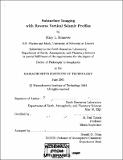Subsurface imaging with reverse vertical seismic profiles
Author(s)
Krasovec, Mary L. (Mary Lee), 1972-
DownloadFull printable version (18.06Mb)
Other Contributors
Massachusetts Institute of Technology. Dept. of Earth, Atmospheric, and Planetary Sciences.
Advisor
M. Nafi Toksöz.
Terms of use
Metadata
Show full item recordAbstract
This thesis presents imaging results from a 3D reverse vertical seismic profile (RVSP) dataset measured at a hydrocarbon bearing pinnacle reef in northern Michigan. The study presented many challenges in seismic data processing and imaging, as the survey geometry was unique in several ways. Reverse VSP, which uses seismic sources in a borehole and receivers on the earth's surface, is fairly rare. RVSP in 3D with a random distribution of surface geophones is unprecedented. At the time this data was collected, no commercially available processing tools existed to address this geometry, so a processing scheme had to be developed. The data processing sequence presented in this thesis, which includes amplitude corrections, first break picking, deconvolution, wavefield separation, and application of statics, takes advantage of the repeatible signature of the new downhole source (Paulsson et al., 1998). Since the data can be handled in common-receiver gathers instead of the usual common-source gathers, it can be treated like several single offset VSPs during the processing sequence. Issues related to the 3D geometry and the random distribution of the receiver array need not be addressed until the imaging step. The generalized Radon transform (GRT) migration method of Miller et al. (1987) provides a high resolution image of a portion of the target reef at 4600 feet (1400 meters) depth. The high resolution of the image is largely due to the downhole source, which generated a high powered signal at frequencies up to several hundred Hertz. Another factor in the high resolution of the image is the success of receiver consistent model-based Wiener deconvolution (Haldorsen et al., 1994), possible because the source signature was repeatable. Due to adverse conditions and power system failure, a large portion of the surface array did not record data. (cont.) The reduced spatial coverage limits the extent of the migrated image, precluding an evaluation of the effectiveness of the random receiver spread. The limited nature of the receiver array also caused artifacts resembling migration smiles in the image. These artifacts are partially suppressed by limiting the aperture of the migration, but this also removes dipping reflectors from the image. To maximize the imaging capibilities of the data, a second approach complimenting the GRT method is developed. This approach, termed vector image isochron (VII) migration, removes array artifacts from the image without losing energy from dipping reflectors. This allows artifacts in the conventional image to be identified, aiding interpretation of the GRT images. VII images also show more even illumination than conventional images, although an effect similar to NMO stretching reduces the resolution of the VII image as compared to the GRT image. The VII scheme is an extension of the GRT migration process of Miller et al. (1987), but involves forming an image which depends on the imaged plane orientation, transforming the image based on the array geometry, then finishing the GRT summation over plane orientations. The VII imaging method is derived in both 2D and 3D with the assumption that the ray paths are straight and that at least one of the arrays, source or receiver, is horizontally oriented. The surface array can have any distribution, regular or random. The other array can have any orientation in general, although this thesis assumes that it will be either another surface array or a vertically oriented borehole array. ...
Description
Thesis (Ph. D.)--Massachusetts Institute of Technology, Dept. of Earth, Atmospheric, and Planetary Sciences, 2001. Includes bibliographical references (p. 147-152).
Date issued
2001Department
Massachusetts Institute of Technology. Department of Earth, Atmospheric, and Planetary SciencesPublisher
Massachusetts Institute of Technology
Keywords
Earth, Atmospheric, and Planetary Sciences.